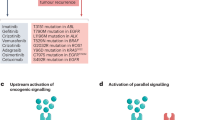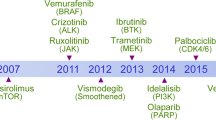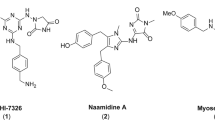Abstract
Advances made in the treatment of childhood malignancies over the past four decades have resulted in overall 5-year survival rates of approximately 80%. However, despite these advances, several childhood cancers still have unacceptably low cure rates, and, even when treatment is successful, the acute and long-term morbidity of current therapy can be substantial. The development of molecularly targeted anticancer drugs offers the prospect of more effective therapy with fewer side effects, but will require increasing partnership between governments, and the academic and private sectors.
This is a preview of subscription content, access via your institution
Access options
Subscribe to this journal
Receive 12 print issues and online access
$209.00 per year
only $17.42 per issue
Buy this article
- Purchase on Springer Link
- Instant access to full article PDF
Prices may be subject to local taxes which are calculated during checkout


Similar content being viewed by others
References
Farber, S. et al. Temporary remissions in acute leukemia in children produced by folic acid antagonist 4-aminopteroylglutamic acid (aminopterin). N. Engl. J. Med. 28, 787–793 (1948).
Jemal, A. et al. Cancer statistics, 2009. CA Cancer J. Clin. 59, 225–249 (2009).
Adamson, P. C. & Blaney, S. M. New approaches to drug development in pediatric oncology. Cancer J. 11, 324–330 (2005).
Bhatia, S. & Meadows, A. T. Long-term follow-up of childhood cancer survivors: future directions for clinical care and research. Pediatr. Blood Cancer 46, 143–148 (2006).
Oeffinger, K. C. et al. Chronic health conditions in adult survivors of childhood cancer. N. Engl. J. Med. 355, 1572–1582 (2006).
Meric-Bernstam, F. & Mills, G. B. Overcoming implementation challenges of personalized cancer therapy. Nature Rev. Clin. Oncol. 9, 542–548 (2012).
Schmitt, M. W., Prindle, M. J. & Loeb, L. A. Implications of genetic heterogeneity in cancer. Ann. NY Acad. Sci. 1267, 110–116 (2012).
Gerlinger, M. et al. Intratumor heterogeneity and branched evolution revealed by multiregion sequencing. N. Engl. J. Med. 366, 883–892 (2012).
Park, B. J., Whichard, Z. L. & Corey, S. J. Dasatinib synergizes with both cytotoxic and signal transduction inhibitors in heterogeneous breast cancer cell lines-lessons for design of combination targeted therapy. Cancer Lett. 320, 104–110 (2012).
Shimizu, T. et al. The clinical effect of the dual-targeting strategy involving PI3K/AKT/mTOR and RAS/MEK/ERK pathways in patients with advanced cancer. Clin. Cancer Res. 18, 2316–2325 (2012).
Survey: Medicines in development for cancer. PhRMA [online] (2011).
The National Academies Press. Safe and Effective Medicines for Children: Pediatric Studies Conducted Under the Best Pharmaceuticals for Children Act and the Pediatric Research Equity Act (Washington D.C., 2012).
Pui, C.-H. et al. Treating childhood acute lymphoblastic leukemia without cranial irradiation. New Engl. J. Med. 360, 2730–2741 (2009).
Law, L. W. Effects of combinations of antileukemic agents on an acute lymphocytic leukemia of mice. Cancer Res. 12, 871–878 (1952).
Goldie, J. H. & Coldman, A. J. The genetic origin of drug resistance in neoplasms: implications for systemic therapy. Cancer Res. 44, 3643–3653 (1984).
Skipper, H. E., Schabel, F. M. Jr & Wilcox, W. S. Experimental evaluation of potential anticancer agents. XIII. On the criteria and kinetics associated with “curability” of leukaemia. Cancer Chemother. Rep. 35, 1–111 (1964).
Pinkel, D., Simone, J., Hustu, H. O. & Aur, R. J. Nine years' experience with “total therapy” of childhood acute lymphocytic leukemia. Pediatrics 50, 246–251 (1972).
Capizzi, R. L., Summers, W. P. & Bertino, J. R. L-asparaginase induced alteration of amethopterin (methotrexate) activity in mouse leukemia L5178Y. Ann. NY Acad. Sci. 186, 302–311 (1971).
Capizzi, R. L. Schedule-dependent synergism and antagonism between methotrexate and L-asparaginase. Biochem. Pharmacol. 23, S151–S161 (1974).
Lobel, J. S., O'Brien, R. T., McIntosh, S., Aspnes, G. T. & Capizzi, R. L. Methotrexate and asparaginase combination chemotherapy in refractory acute lymphoblastic leukemia of childhood. Cancer 43, 1089–1094 (1979).
Capizzi R. L. Asparaginase-methotrexate in combination chemotherapy: schedule-dependent differential effects on normal versus neoplastic. Cancer Treat. Rep. 65, 115–121 (1981).
Pinkel, D. et al. Drug dosage and remission duration in childhood lymphocytic leukemia. Cancer. 27, 247–256 (1971).
Hryniuk, W. & Bush, H. The importance of dose intensity in chemotherapy of metastatic breast cancer. J. Clin. Oncol. 2, 1281–1288 (1984).
Hryniuk, W. & Levine, M. N. Analysis of dose intensity for adjuvant chemotherapy trials in stage II breast cancer. J. Clin. Oncol. 4, 1162–1170 (1986).
Cheung, N. V. & Heller, G. Chemotherapy dose intensity correlates strongly with response, median survival, and median progression-free survival in metastatic neuroblastoma. J. Clin. Oncol. 9, 1050–1058 (1991).
Gaynon, P. S. et al. Association of delivered drug dose and outcome for children with acute lymphoblastic leukemia and unfavorable presenting features. Med. Pediatr. Oncol. 19, 221–227 (1991).
Bacci, G. et al. The importance of dose-intensity in neoadjuvant chemotherapy of osteosarcoma: a retrospective analysis of high-dose methotrexate, cisplatinum and adriamycin used preoperatively. J. Chemother. 2, 127–135 (1990).
Smith, M. A., Ungerleider, R. S., Horowitz, M. E. & Simon, R. Influence of doxorubicin dose intensity on response and outcome for patients with osteogenic sarcoma and Ewing's sarcoma. J. Natl Cancer Inst. 83, 1460–1470 (1991).
Womer, R. B. et al. Randomized comparison of every-two-week v. every-three-week chemotherapy in Ewing sarcoma family tumors (ESFT). J Clin Oncol. Abstr. 26, 10504 (2008).
Strother, D. et al. Feasibility of four consecutive high-dose chemotherapy cycles with stem-cell rescue for patients with newly diagnosed medulloblastoma or supratentorial primitive neuroectodermal tumor after craniospinal radiotherapy: results of a collaborative study. J. Clin. Oncol. 19, 2696–2704 (2001).
Welte, K. et al. A randomized phase-III study of the efficacy of granulocyte colony-stimulating factor in children with high-risk acute lymphoblastic leukemia. Berlin-Frankfurt-Munster Study Group. Blood 87, 3143–3150 (1996).
Burdach, S. E. et al. Granulocyte-macrophage-colony stimulating factor for prevention of neutropenia and infections in children and adolescents with solid tumors. Results of a prospective randomized study. Cancer 76, 510–516 (1995).
Hawkins, D. S. et al. Peripheral blood stem cell support reduces the toxicity of intensive chemotherapy for children and adolescents with metastatic sarcomas. Cancer 95, 1354–1365 (2002).
Smith, M. A. et al. Outcomes for children and adolescents with cancer: challenges for the twenty-first century. J. Clin. Oncol. 28, 2625–2634 (2010).
Malogolowkin, M. H. et al. Intensified platinum therapy is an ineffective strategy for improving outcome in pediatric patients with advanced hepatoblastoma. J. Clin. Oncol. 24, 2879–2884 (2006).
Michel, G. et al. Use of recombinant human granulocyte colony-stimulating factor to increase chemotherapy dose-intensity: a randomized trial in very high-risk childhood acute lymphoblastic leukemia. J. Clin. Oncol. 18, 1517–1524 (2000).
Crist, W. M. et al. Intergroup rhabdomyosarcoma study-IV: results for patients with nonmetastatic disease. J. Clin. Oncol. 19, 3091–3102 (2001).
Reulen R. C. et al. Long-term cause-specific mortality among survivors of childhood cancer. JAMA 304, 172–179 (2010).
Survey: Medicines in development for cancer. PhRMA [online] (2006).
Zhang, J. et al. A novel retinoblastoma therapy from genomic and epigenetic analyses. Nature 481, 329–334 (2012).
Zhang, J. et al. The genetic basis of early T-cell precursor acute lymphoblastic leukaemia. Nature 481, 157–163 (2012).
Schultz, K. R. et al. Improved early event-free survival' with imatinib in Philadelphia chromosome-positive acute lymphoblastic leukemia: a children's oncology group study. J. Clin. Oncol. 27, 5175–5181 (2009).
Henderson, E. S. Treatment of acute leukemia. Ann. Intern. Med. 69, 628–632 (1968).
Monga, M. & Sausville, E. A. Developmental therapeutics program at the NCI: molecular target and drug discovery process. Leukemia 16, 520–526 (2002).
Kung, A. L. Practices and pitfalls of mouse cancer models in drug discovery. Adv. Cancer Res. 96, 191–212 (2007).
Voskoglou-Nomikos, T., Pater, J. L. & Seymour, L. Clinical predictive value of the in vitro cell line, human xenograft, and mouse allograft preclinical cancer models. Clin. Cancer Res. 9, 4227–4239 (2003).
Carol, H. et al. Initial testing of the MDM2 inhibitor RG7112 by the pediatric preclinical testing program. Pediatr. Blood Cancer. 2 Jul 2012 (doi:10.1002/pbc.24235).
Smith, M. A. et al. Evaluation of arsenic trioxide by the pediatric preclinical testing program with a focus on Ewing sarcoma. Pediatr. Blood Cancer 59, 753–755 (2012).
Gillis, J. & Loughlan, P. Not just small adults: the metaphors of paediatrics. Arch. Dis. Child. 92, 946–947 (2007).
Kearns, G. L. et al. Developmental pharmacology--drug disposition, action, and therapy in infants and children. N. Engl. J. Med. 349, 1157–1167 (2003).
Balis, F. M. et al. Pharmacokinetics and pharmacodynamics of oral methotrexate and mercaptopurine in children with lower risk acute lymphoblastic leukemia: a joint children's cancer group and pediatric oncology branch study. Blood 92, 3569–3577 (1998).
Crom, W. R. et al. Pharmacokinetics of anticancer drugs in children. Clin. Pharmacokinet. 12, 168–213 (1987).
Panetta, J. C., Iacono, L. C., Adamson, P. C. & Stewart, C. F. The importance of pharmacokinetic limited sampling models for childhood cancer drug development. Clin. Cancer Res. 9, 5068–5077 (2003).
Relling, M. V. et al. Pharmacogenetic risk factors for osteonecrosis of the hip among children with leukemia. J. Clin. Oncol. 22, 3930–3936 (2004).
Rocha, J. C. et al. Pharmacogenetics of outcome in children with acute lymphoblastic leukemia. Blood 105, 4752–4758 (2005).
Pinto, N., Cohn, S. L. & Dolan, M. E. Using germline genomics to individualize pediatric cancer treatments. Clin. Cancer Res. 18, 2791–2800 (2012).
Hunger, S. P., Raetz, E. A., Loh, M. L. & Mullighan, C. G. Improving outcomes for high-risk ALL: translating new discoveries into clinical care. Pediatr. Blood Cancer 56, 984–993 (2011).
Kang, H. et al. Gene expression classifiers for relapse-free survival and minimal residual disease improve risk classification and outcome prediction in pediatric B-precursor acute lymphoblastic leukemia. Blood 115, 1394–1405 (2010).
Mullighan, C. G. et al. JAK mutations in high-risk childhood acute lymphoblastic leukemia. Proc. Natl Acad. Sci. USA 106, 9414–9418 (2009).
Mullighan, C. G. et al. Deletion of IKZF1 and prognosis in acute lymphoblastic leukemia. N. Engl. J. Med. 360, 470–480 (2009).
Mullighan, C. G. New strategies in acute lymphoblastic leukemia: translating advances in genomics into clinical practice. Clin. Cancer Res. 17, 396–400 (2011).
Adamson, P. C., Bagatell, R., Balis, F. M. & Blaney, S. M. in Principles and Practice of Pediatric Oncology (eds Pizzo, P. A. & Poplack, D.G.) 6th edn 279–255 (Lippincott Williams & Wilkins, 2011).
Alcorn, J. & McNamara, P. J. Phamacokinetics in the newborn. Adv Drug. Delivery Rev. 55, 667–686 (2003).
de Wildt, S. N., Johnson, T. N. & Choonara, I. The effect of age on drug metabolism. Paediatric Perinatal Drug Ther. 5, 101–106 (2003).
Bissinger, R. L. Renal physiology part 1: structure and function. Neonatal Netw. 14, 9–20 (1995).
Author information
Authors and Affiliations
Corresponding authors
Ethics declarations
Competing interests
The authors declare no competing financial interests.
Related links
Rights and permissions
About this article
Cite this article
Norris, R., Adamson, P. Challenges and opportunities in childhood cancer drug development. Nat Rev Cancer 12, 776–782 (2012). https://doi.org/10.1038/nrc3370
Published:
Issue Date:
DOI: https://doi.org/10.1038/nrc3370
This article is cited by
-
Early detection of myocardial changes with and without dexrazoxane using serial magnetic resonance imaging in a pre-clinical mouse model
Cardio-Oncology (2021)
-
Therapy concepts in the context of precision medicine for pediatric malignancies—children are not adults
memo - Magazine of European Medical Oncology (2021)
-
Paediatric Oncology at the Crossroads: A Call for Change
Pharmaceutical Medicine (2020)
-
Patient-derived xenograft models in musculoskeletal malignancies
Journal of Translational Medicine (2018)
-
Early phase clinical trials of anticancer agents in children and adolescents — an ITCC perspective
Nature Reviews Clinical Oncology (2017)



